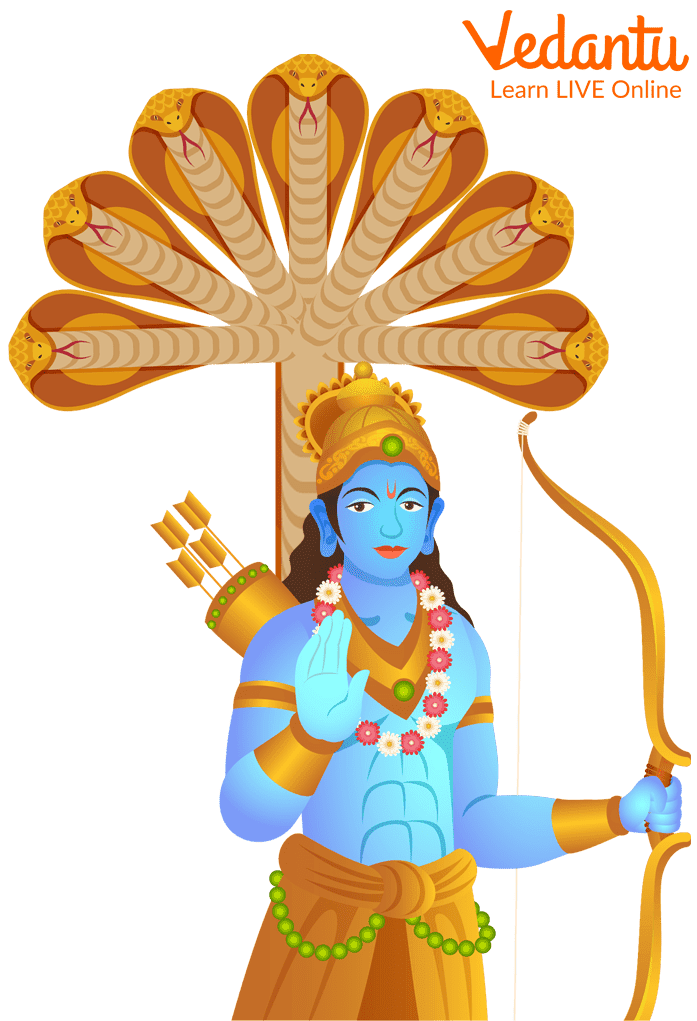Lord Vishnu Story

Introduction to the Story
One of the main Hindu deities is Vishnu. Through his various avatars, especially Rama and Krishna, Vishnu combines a variety of minor gods and goddesses and local heroes. He has countless appearances; he is frequently said to have 10 avatars, though they aren't always the same 10. Vasudeva, Narayana, and Hari are three of the 1,000 names of Vishnu that his worshipers repeat as an act of devotion.
Lord Vishnu Story in English
On a bed made of the coils of the thousand-hooded great serpent Adishesha, who has infinite dimensions, Vishnu resides in the milky waters of Vaikunth. His consort, the goddess Lakshmi, looks after him. The ocean represents joy and consciousness, the serpent represents time, diversity, desire, and illusion, and the goddess Lakshmi represents the physical world and the creative forces. Vishnu is represented by the colour of a deep blue cloud.
It is the colour of the sky, signifying his cosmic dimensions, his affinity for the Vedic gods of thunder and rain, as well as his connection to the earth. He is typically shown with one face, four arms, and either in a standing or resting position.

Lord Vishnu
Sankha (a conch), chakra (a disc), gada (a mace), and padma (a lotus) are each held in turn by his four arms. The five elements, the AUM sound, the salagrama, the goddess Lakshmi, the waters, purity, and perfection are represented by the conch. Vishnu's terrible weapon of choice to fight evil and defend the just was the discus. It stands in for the sun's light, which disproves and illuminates darkness.
Additionally, it represents a higher consciousness that dispels all illusions. The lotus represents beauty, harmony, purity, the water element, creation, and self-realisation, while the mace represents the power of knowledge.
Lord Vishnu Avatars
First Avatar: The Hindu version of the biblical Noah, Saint Vaivasvata, was saved by Vishnu in his Matsya or Fish incarnation (or vice versa).
Second Avatar: At the Churning of the Ocean, Vishnu in the form of Koorma (or Kurma) offered his back as a pivot for Mount Mandara, which was used as a churning stick by gods and demons.
Third Avatar: As Vishnu's boar incarnation, Varaha, he vanquished the demon Hiranyaksha, retrieved the stolen Vedas, and freed the Earth from the ocean's depths.
Fourth Avatar: As a creature that was half-lion and half-man, Narasingha, also known as the Lion Incarnation.
Fifth Avatar: Bali, a demon who had taken control of the Earth, was defeated by Vamana, the Dwarf incarnation.
Sixth Avatar: Parasurama, he defeated King Kartavirya for stealing the sacred cow Kamadhenu, which had the power to grant all wishes.
Seventh Avatar: Ram: He defeated Sita's kidnapper, the demon King Ravana.
Eight Avatar: Kansa, the oppressive ruler of Mathura and the demon's son, was defeated by Krishna.
Ninth Avatar: Buddha: Vishnu took human form to end suffering in the world.
Tenth Avatar: At the conclusion of the Kaliyuga, or current age of decline, Vishnu will physically manifest on Earth as Kalki, his tenth incarnation, riding a white horse.
Moral of the Story
To demonstrate the lesson that "Wealth eludes the insecure," Vishnu assumed the form of Kurma. Vishnu's function as a protector and preserver is once more made clear through this avatar as he looks out for the gods in order to aid them in recovering and preserving their divine abilities.
Conclusion
The Saptarishis are created by Brahma in order to teach humanity. We all refer to Lord Vishnu as Palankarta, which means "sustainer, preserver, and protector," and it is thought that He existed before the universe was created. People frequently ponder the origins of the Story of the birth of Lord Vishnu.


FAQs on Lord Vishnu Story
1. Who is Lord Vishnu's wife?
The Hindu goddess of fortune, wealth, and prosperity, Lakshmi, is the spouse and vital force of Vishnu.
2. Who is the god of Vishnu?
The god of preservation and supreme maintainer, Vishnu frequently expresses as different incarnations (avatara) to save humanity.
3. Who emerged first, Vishnu or Shiva?
Vishnu Purna characteristics When Vishnu first began to exist, a lotus with Brahma inside of it grew from his navel, and Shiva appeared from his left side.




